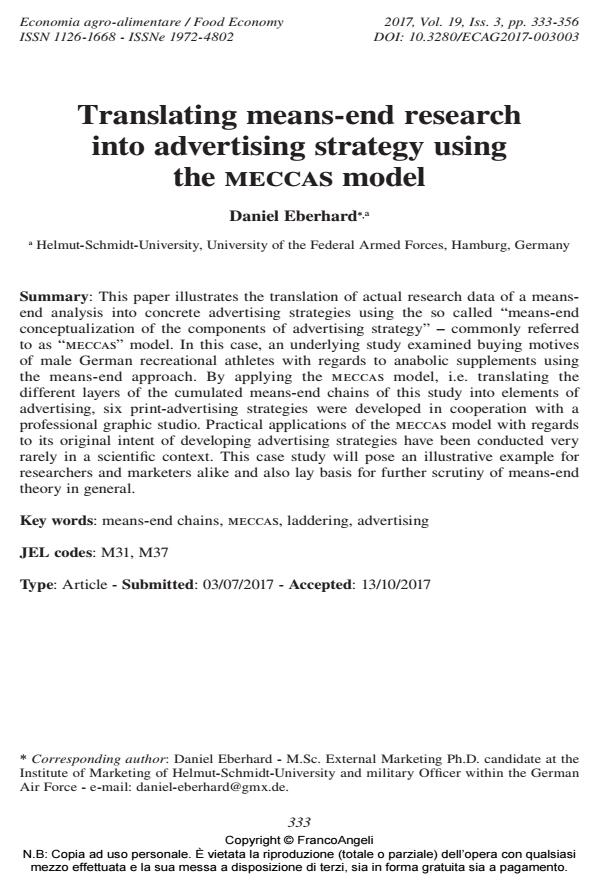Translating means-end research into advertising strategy using the meccas model
Journal title ECONOMIA AGRO-ALIMENTARE
Author/s Daniel Eberhard
Publishing Year 2017 Issue 2017/3
Language English Pages 24 P. 333-356 File size 292 KB
DOI 10.3280/ECAG2017-003003
DOI is like a bar code for intellectual property: to have more infomation
click here
Below, you can see the article first page
If you want to buy this article in PDF format, you can do it, following the instructions to buy download credits

FrancoAngeli is member of Publishers International Linking Association, Inc (PILA), a not-for-profit association which run the CrossRef service enabling links to and from online scholarly content.
This paper illustrates the translation of actual research data of a meansend analysis into concrete advertising strategies using the so called "means-end conceptualization of the components of advertising strategy" - commonly referred to as "meccas" model. In this case, an underlying study examined buying motives of male German recreational athletes with regards to anabolic supplements using the means-end approach. By applying the meccas model, i.e. translating the different layers of the cumulated means-end chains of this study into elements of advertising, six print-advertising strategies were developed in cooperation with a professional graphic studio. Practical applications of the meccas model with regards to its original intent of developing advertising strategies have been conducted very rarely in a scientific context. This case study will pose an illustrative example for researchers and marketers alike and also lay basis for further scrutiny of means-end theory in general.
Keywords: Means-end chains, meccas, laddering, advertising
Jel codes: M31, M37
- What motivates customers to purchase from social commerce pages? A means-end chain approach Pranay Sindhu, Kumkum Bharti, in Information Technology & People /2025
DOI: 10.1108/ITP-10-2022-0735 - Driving participation and investment in B2B trade shows: The organizer view Roberto Mora Cortez, Wesley J. Johnston, Srinath Gopalakrishna, in Journal of Business Research /2022 pp.1092
DOI: 10.1016/j.jbusres.2022.01.028 - Methodological considerations on the means‐end chain analysis revisited Fleur B. M. Kilwinger, Ynte K. van Dam, in Psychology & Marketing /2021 pp.1513
DOI: 10.1002/mar.21521
Daniel Eberhard, Translating means-end research into advertising strategy using the meccas model in "ECONOMIA AGRO-ALIMENTARE" 3/2017, pp 333-356, DOI: 10.3280/ECAG2017-003003